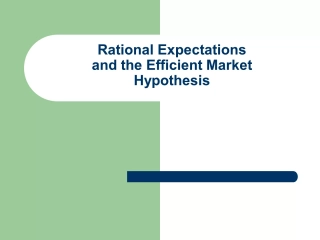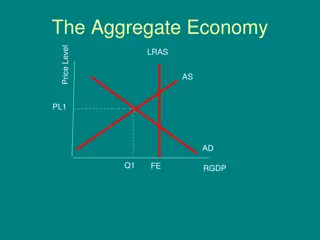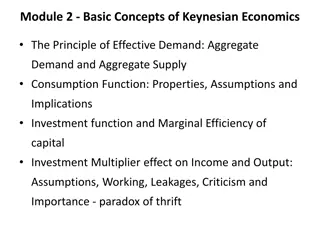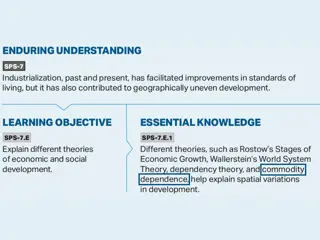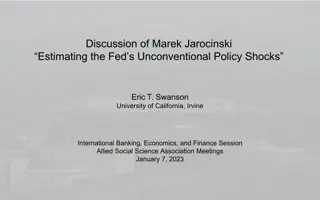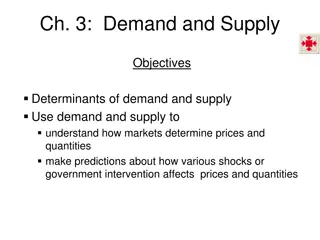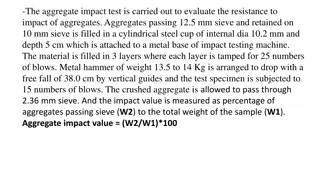Estimation of Aggregate Demand and Supply Shocks Using Commodity Transaction Data
This study presented at Hitotsubashi-RIETI Workshop analyzes demand and supply shocks using commodity transaction data. By estimating elasticity parameters and examining movements in price and quantity, the research identifies negative supply shocks post-global financial crisis and after 2013. The paper also delves into interactions between product turnover and macroeconomic shocks, contributing to new macroeconomic studies. Overall, it sheds light on the dynamics of aggregate demand and supply shocks with implications for economic trends.
Download Presentation

Please find below an Image/Link to download the presentation.
The content on the website is provided AS IS for your information and personal use only. It may not be sold, licensed, or shared on other websites without obtaining consent from the author. Download presentation by click this link. If you encounter any issues during the download, it is possible that the publisher has removed the file from their server.
E N D
Presentation Transcript
Comments on Estimation of Aggregate Demand and Supply Shocks Using Commodity Transaction Data at Hitotsubashi-RIETI Workshop on Real Estate Market, Productivity, and Prices on October 13, 2016 Tsutomu Miyagawa (RIETI and Gakushuin University) 1
1. Outline of the Paper Estimation of demand and supply shocks using commodity-level data an alternative to the time series approach using aggregate data. Analytical procedure (i) Specifying demand and supply functions (ii) Estimating category-level elasticity parameters using GMM with three moment conditions (iii)Based on the estimation results, authors obtain aggregate demand and supply shocks (iv)Checking the consistency of their estimated results with the movements in aggregate price and quantity 2
1. Outline of the paper (contd.) Main results (i) They find negative supply shocks after the global financial crisis and after 2013. (ii) The movements in demand shocks in the case where new products are considered different from those in the case they are not. The former results explain the stock piling behavior before the increase in the consumption tax rate on April 2014. product turnover is an important factor for the business cycles. (iii)The movements in price and quantity at the global financial crisis and during Abenomics are well explained by negative supply shocks and positive demand shocks. 3
2. Contributions of the Paper Blanchard (NBER WP 14259, 2008) addressed the point that the components and parameters of the DSGE model should be consistent with the estimated parameters using micro data. Following his arguments, this paper studies the movements in aggregate demand and supply shocks based on the micro data. This paper also contributes to the new macroeconomic study on the interactions between product turnover and macroeconomic shocks. 4
2. Contributions of the paper (contd.) Two approaches on the interaction between product turnover and macroeconomic issues: a consumption side approach and a production side approach. Advantages of the consumption side approach: more sophisticated classification in products and more appropriate frequency for business cycle analysis. Advantages of the production approach: larger coverage for sales, better for the productivity study. Disadvantages of both approaches: the lack of service 5
Abe et al. Dekle et al. Syakaichosa-kenkyujo Retail Index Census of Manufacturers Data source Number of categories 1,057 1,768 Number of producers (establishments) 5,613 263,061(2008) Coverage Consumption goods Manufacturing goods Data frequency weekly annual Sales (Shipments)(in millions of yen) 495,660* 20,146,219 2008 New product ratio 0.3 0.12 * I converted the monthly transaction data in Table 1 to annual transaction data. 6
3. Comments and Suggestions Major comments (i) Lack of durable goods: consumption in durable goods is sensitive to changes in consumption tax and wealth. Do the authors have any intention including durable goods in their study? (ii) Are the movements in price using SRI data consistent with or different from CPI (non-durable goods) ? The difference between consumer price measured in this paper and CPI affects the implications of the aggregate demand and supply shocks. 7
3. Comments and suggestions (contd.) (iii) Using barcode-level price data leads to downward bias, because it includes price in exit goods. Why don t the authors show the price data series without product turnover? In addition, the author should show the product destruction rate as shown in Broda and Weinstein. (iv) Endogeneity of product turnover: Bilbiie. Ghironi, and Melitz (JPE, 2012), and Dekle, Jeong, and Kiyotaki (2014) endogenize entry and exit behavior and product turnover. The authors are then able to check whether the new product ratio is affected by aggregate shocks. Minor comments - The paper can be improved, if the authors show some examples of product turnover in their data. 8



